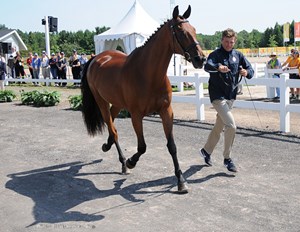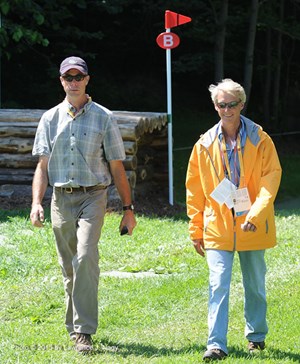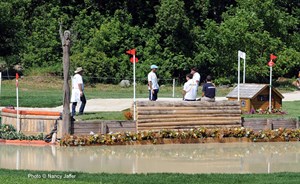July 16, 2015 — About 20 minutes from the OLG Caledon Equestrian Center, where the bulk of the Pan American Games equestrian competition is being held, you’re in a completely different world.
 Boyd Martin and Pancho Villa looked like a pair ready to rock at the Pan Am Games. | Photo copyright 2015 by Lawrence J. Nagy
Boyd Martin and Pancho Villa looked like a pair ready to rock at the Pan Am Games. | Photo copyright 2015 by Lawrence J. NagyWhile the equestrian center is on the edge of suburbia (indeed, McMansions are going up at quite a pace near the entrance to the facility), the cross-country course for eventing is in a still-rural area dense with evergreens. It looks just as you imagine Canada should.
Today we were able to walk the course with Graeme Thom, a member of the Pan Am organizing committee who has served as the cross-country site supervisor and also served as his country’s chef d’equipe until last year.
He had many interesting insights. If you think you know something about eventing, go around a course with a knowledgeable guy such as Graeme and you’ll learn a lot more.
The route designed by Australian Wayne Copping, who handled the layout for Adelaide’s 4-star, makes complete use of the land available at Will O’ Wind farm. The facility is neatly nestled in the hills more than an hour from Toronto, in an area where there seems to be nearly as many dirt roads as paved streets.
The course was beautifully built by American Eric Bull, who was able to make it speak to its location with fences replicating a barn and a log cabin, carved animals, including a beaver, a raccoon and of course, a Canada goose, as well as a jump emblazoned by a maple leaf. It’s a 5-foot drop, four curving strides from a jumpable jug of maple syrup, for those who care to take the direct route. The final element involves going up a hill to clear a log at the top on a left-to-right angle.
 Eric Bull and Graeme Thom | Photo copyright 2015 by Lawrence J. Nagy
Eric Bull and Graeme Thom | Photo copyright 2015 by Lawrence J. Nagy“This will be, I think, one of the more influential fences,” said Graeme.
“The people that will go the direct route here are the people who will try to be competitive.”
The optimum time is 8 minutes, 39 seconds. I’m betting the clock will be a huge factor in the proceedings.
Eric believes a good number of entries will be caught out early. Those who are not prepared properly will have neither the endurance nor the strategy to gallop through the finish line.
At the horse inspection later in the day, I noticed several animals looked as if they could use more groceries and a slicker finish. Fit is one thing; too thin is quite another.
While Canada and the U.S. are at the top of the curve in everything from horse care to conditioning and intelligent riding, the opportunities are not always there to learn about such things in smaller countries where the sport isn’t popular. So Eric’s prediction probably is correct.
I wondered how different it was to be working on a course for an international championship, as opposed to a regular two-star. Here’s what he told me.
Interestingly, the portable fences were made in Virginia and trucked up here on three tractor-trailers. But other fences, such as the maple leaf drop, were built into the landscape.
While two water complexes provide multi-obstacle challenges, it’s nice to see that the designer knows who will be competing and has laid out many very sensible long routes. Smart riders who realize they’re not up to the top level of the sport can utilize those and still finish.
 The Uruguayan team checks out the first water on the cross-country course. | Photo copyright 2015 by Nancy Jaffer
The Uruguayan team checks out the first water on the cross-country course. | Photo copyright 2015 by Nancy JafferI think for many here, that is the goal. The U.S., of course, has quite a different agenda. The team was unable to complete the competition at the 2014 World Equestrian Games, where the top six countries qualified for next year’s Rio Games. Canada was one of them (after sixth-place France was disqualified following a positive drug test for one of its horses.)
The U.S. doesn’t have to win to make the cut for Rio. If Canada wins — and the team is highly motivated because this is their country and they want to shine in front of a home crowd — and the U.S. is second, it can still qualify, since Canada is already home-free. Brazil could be in the medals, but again, if it finishes ahead of the U.S. and behind Canada (just one of several possible scenarios) the U.S. still would qualify because Brazil already has its ticket as the hometown team.
After walking the course with his squad, U.S. coach David O’Connor took the time to talk with me about his reaction to it. Click on this soundbyte to hear what he had to say.
 Qorry Blue D’Argouges was held after a sharp look from the veterinarian and the ground jury, but finally Canada’s Colleen Loach got the all clear | Photo copyright 2015 by Lawrence J. Nagy
Qorry Blue D’Argouges was held after a sharp look from the veterinarian and the ground jury, but finally Canada’s Colleen Loach got the all clear | Photo copyright 2015 by Lawrence J. NagyOnly one horse, from Colombia, was spun at the inspection. There were, however, some tense moments, as the ground jury and veterinarian were really looking closely at every entry. Canada’s Qorry Blue D’Argouges had to jog twice and then was held; a tense time for rider Colleen Loach and her squad. But on a return trip to the jogging strip, the big gray was passed and the Canadians could breathe again.
The U.S. horses all passed on the first try. That left reserve rider Jennie Brannigan on the outside looking in with Cambalda. At least she got the outfits that go with being on the squad. Riders were told they needed to wear the clothes they had been given when they were on the showgrounds.
They weren’t quite a uniform; the South Americans had that cornered. It was surprising how many, from Mexico to Argentina, were in military garb. The army still obviously plays a role in equestrian sport in those countries. The U.S. army gave it up after World War II (the 1948 Olympics to be exact.)
 Marilyn Little floats over the ground on her ruby slippers as she trots up RF Scandalous | Photo copyright 2015 by Lawrence J. Nagy
Marilyn Little floats over the ground on her ruby slippers as she trots up RF Scandalous | Photo copyright 2015 by Lawrence J. NagyThe U.S. riders wore blue jackets and white pants. That put a damper on Marilyn Little’s normal instinct to dress for success in the jog with eye-catching outfits. But she found a way around it.
Marilyn wore a pair of bright red shoes with light-catching metal decorations around the outside, an opportunity for self-expression.
“I presume that was not part of the team uniform,” I commented.
“They said `red shoes,’ and these are red,” she replied with a twinkle in her eye.
For a closeup of the shoes (and other photos as well), go to www.facebook.com/practicalhorseman.
Marilyn is aboard RF Scandalous, and I wondered how she thinks the mare will handle the challenge.
Click on the soundbyte to hear her thoughts.
Things get under way in earnest tomorrow with dressage. Tomorrow night, I’ll keep you up to date with my next postcard.
Until then,












